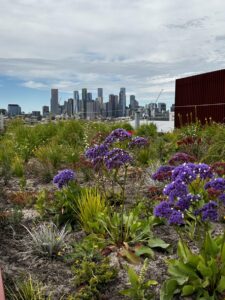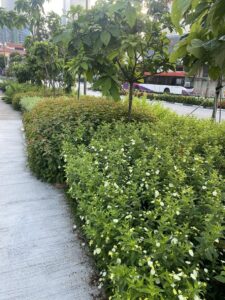Dense and diverse urban planting – popular or misunderstood?
By Michael Casey
Is the adoption of dense and diverse urban planting on the rise, or is it simply misunderstood?
Urban density and growth is on the rise, and currently the increased numbers are on an upward trajectory and is happening faster than we have ever experienced in human history, with an additional two billion people expected in urban areas by 2050.
As we strive for more available and affordable methods of supplying housing and shelter, we will continue to be confronted by the need for more accessible land. However, where, in this search for land, will we set aside areas designed to include nature that provide numerous beneficial biodiversity and ecosystem benefits?
Green spaces need to be dense enough to provide as many of the sustainability benefits that a busy city requires for optimal environmental and social health.
Currently, our cities provide a variety of green spaces such as natural and semi-natural vegetated environments along with artificial ecological systems and remnant habitat patches. For some time we have been more commonly drawn to seeing landscaped open spaces such as parklets, streetscapes and verges that consist of mass plantings of single species, which are set out with a planting palette that allows for easy and minimal maintenance and often displaying no aesthetic appeal at all.

Recently, the use of more diverse planting schemes has seen new and bold approaches to the creation of decorative and more manageable landscapes.
There is currently ongoing research carried out by our educational facilities working towards understanding more about the benefits that some green spaces can provide. This includes improved air quality and storm water mitigation through to the positive impacts of vegetation on mental restoration. With aesthetic preferences and appeal front of mind in any new installation, we, the industry, are now able to design and deliver greenspaces with a more diverse plant palette to help enhance these key social, environmental and economic benefits.
The woody meadow project created by the University of Melbourne, alongside other organisations, uses naturalistic plantings of Australian shrubs to improve the appearance and function of low-maintenance landscapes. This research, and installations of green spaces, addresses how a managed horticultural approach using selected plant species in a greenspace over a period of time can change the appearance of our often-bland streetscapes, and transform them into a hot spot for biodiversity and colour. This management of plants incorporates a diverse group of plants that replicates the structure of shrub-based natural ecosystems and provides visual interest.
Species are often selected based on their capacity to regenerate after fire or other disturbances. Woody Meadows are maintained by coppicing all plants every one to three years to promote continuous and varied flowering display, and achieve rapid canopy closure to exclude weeds. With the benefits these green spaces provide, there are sometimes downsides as can be seen when the plants require heavy coppicing. This technique seems to be misunderstood by the public, and their true perception of green spaces being manicured and kept green is compromised by seeing plants trimmed heavily to the ground.
Singapore, the city that prides itself on being green and a city in nature, is also changing its tactic on how to green its streetscapes with several new roadside plantings like the one at Maxwell Station comprising diverse plantings and no manicured grass settings. The maintenance now goes back to plant maintenance and horticultural knowledge, not mowing and trimming massed plantings of informal hedges. This change also includes signage and education of National Parks’s intent to add a more diverse range of plants to enhance biodiversity.

Roof gardens are looked upon as a popular choice and are sometimes used more as a ‘landscape on structure’ that can cover underground car parks etc. Intensive roof gardens that typically are gardens planted into sometimes deeper substrates, can often be mass planted with a handful of species, creating blocks of species grouped together. The mass planting of a few commonly known species may create an ease for maintenance but often leaves little for the aesthetic appeal of an open space. It can also create issues when species struggle, due to insect or disease issues, and large areas of landscape fail leaving vast areas damaged and visually unappealing. Sometimes, working with plant species that work well together and provide a maximum visual appeal may be a simpler solution for actually addressing an ease in maintenance, along with providing a healthy and well-functioning eco system. But again, education is required in more diverse plantings as the expectation for always green and flowering can sometimes be misinterpreted.
On the other hand, green roofs, set out on top of roof spaces that typically have shallower planting depths, have in times been heavily planted out – up to 20 plants per square metre. Plantings at this density tend to assist in preventing the soil media from blowing off the roof, along with helping with the establishment of the plants. While dense plantings of a handful of species is a reliable way of planting for survival and establishment, we may need to address how we can identify other varieties to assist this process. More diverse plant species could be used in similar ways and work towards a more appealing landscape, while using less plants in the process. A more diverse plant palette and carefully choosing plants that work well together, may work towards a more desirable outcome for establishment, maintenance and aesthetic appeal, and imagine the boost to the local biodiversity.

The popularity of more diverse plant choices starts with increasing education to the industry and community. The level of community and professional engagement along with participation in urban planting initiatives may assist with this and further improve their popularity. When communities are actively involved in the planning and education of green spaces, it often leads to greater acceptance and support, and a much-needed push to see plant species and new techniques used in open green spaces. We love plants, but sometimes the look of single-species mass plantings, used to minimise maintenance, is only going to ensure the community thinks this is what our green spaces must look like.
Dense and diverse urban plantings are a popular choice but the misunderstanding around diverse plantings can vary widely and is often due to lack of education about green spaces. Depending on local factors such as awareness and education, the true extent to which the full benefits of such plantings are recognised and embraced by the community and policy makers, will only be known when successful spaces are embraced. As the benefits become better understood and appreciated, and as cities face increasing environmental challenges, the popularity of urban planting is likely to increase.
Michael Casey, Director of Evergreen Infrastructure
Consultant and advisor to the green infrastructure industry
E: michael@evergreeninfrastructure.com.au
Main photo: Colour achieved through plant diversity (Image: Michael Casey)

